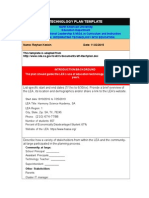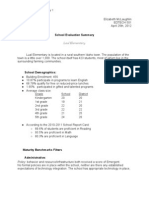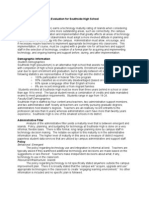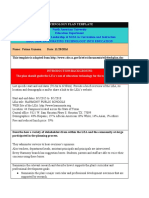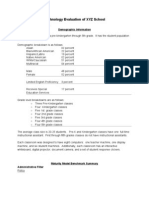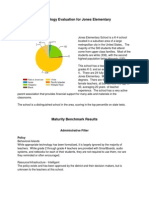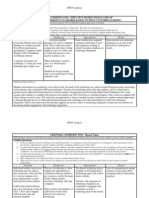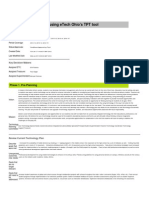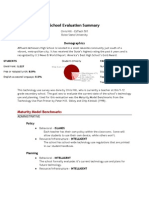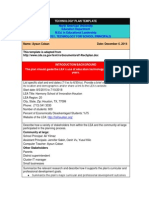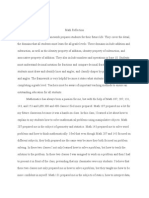Evaluation School - WalkerE
Evaluation School - WalkerE
Uploaded by
Eldon WalkerCopyright:
Available Formats
Evaluation School - WalkerE
Evaluation School - WalkerE
Uploaded by
Eldon WalkerOriginal Description:
Copyright
Available Formats
Share this document
Did you find this document useful?
Is this content inappropriate?
Copyright:
Available Formats
Evaluation School - WalkerE
Evaluation School - WalkerE
Uploaded by
Eldon WalkerCopyright:
Available Formats
1
Rural School District Overview
The Rural School District consists of nine schools: a high school (grades 9-12), an alternative high school, a middle school (6-8), and six other schools comprising the primary grades (K-5). Currently, there are approximately 2,116 students in the district. The district administration consists of a superintendent, assistant superintendent, and support staff; each school has a principal and an assistant principal , with support staff. An elected school board oversees the workings of the district. The school at this point follows a regular academic year, no summer school offered, and no around-the-year programs. The current district budget for 2012-13 is $23,638,831 with $491,156 designated for the districts technology departments salaries and benefits. The current revised budget does not designate line items allocated for technology training, separate from what the technology staff or instructional coaches can provide.
An educational technology specialist was hired for the first time in the district for the 2012-13 academic year. Each school has a designated instructional coach to work with the teachers at each building. The district technology committee has adopted the International Society for Technology in Education (ISTE) standards as a framework for planning and guidance. However, in conversing with a teacher in one of the primary schools, she had never heard of the ISTE. There are a few on-line software programs that are required to be used by faculty in the primary grades: PLATO, Earobics, AIMSweb, Apangea. These are all for primary grades in remediation for math and reading, and assessment (AIMSweb).
Students can access remediation programs online from home as well. Renaissance Home Connect is popular in high school for advanced placement math students. In addition, all faculty have to use PASS (Parental Access Support System) weekly. This is especially useful in the high school where the academic standards of athletes,and others involved in extracurricular activities, must meet academic requirements. Any parent in the school district can log into this system and check on the progress of their student. Outside of the above on-line programs, currently, there is no directive that teachers in the district have to use any A/V equipment or technology in the curriculum. Some faculty have taken upon themselves to use Moodle (which is available) in their teaching, but without formal, organized training from the district. It is amazing that the assessment and tracking of the use of on-line programs, technology in the classrooms, parental access to PASS, utilization by students of any remediation programs while at home or at school, and the programs or websites the faculty frequent for educational instruction is not being tracked or assessed at the school or district level. Furthermore, other than the required two sessions for SMART training, all other training in the aspects of educational technology is optional or nonexistent for teachers in the district. Each teacher is flying solo to gain knowledge, improve skills, seek out ideas, or incorporate new ideas. Incidentally, the SMART training is only for basic knowledge on how to turn on and use the buttons and options, not how to incorporate the technology in courses or curriculum. It would be recommended that assessments of all of these things would take place so that educational technology in this school district can be expanded.
Administrative Filter
1. Policy: The Rural School District has a one-page technology policy, adopted in 2004, that applies to all schools within the district. The policy recites the legislatures plan that students are introduced to current technology. Distance Learning Settings and Cooperative Instructional Initiatives are the two aspects of the policy. Also based on districts budget and the needs of the schools, new equipment will be purchased and training of staff will be provided. Further, the policy states that an assessment will be done in each classroom of the district to distinguish the quantity and quality of the available equipment, the application of technology for instructional purposes, staff training needs, and the methods by which the students receive instruction and the opportunity for application of technology, and the use of technology in record keeping and communication. 2. Planning: Based on the budgets of 2010-11 and 2011-12, a levy was passed in the district and money was designated to update technology in each classroom in the district, and hire more staff for technology hardware maintenance and a education technology expert. The districts technology plan, after an assessment analysis and
receiving bids from vendors, each classroom in the district would receive a SMART Board, microphone, ceiling-mounted projector, and audio speakers. At this point in the 2012-2011 year, the assessment on the methods of course instruction, and opportunities for application of technology have not taken place. Also in the plan for the 2011-12 was the implementation of the Students Come First plan, which is dependent on the passage and funding from the state on Propositions 1, 2 and 3. This Students Come First plan would replace computers in each classroom and all students would be district would be given a laptop to use while in school and at home. These did not meet voter approval in November 2012, so advancement of this plan is now on hold. 3. Budget: The budget for the 2011-12 academic year funded installation of SMART Boards in 202 classrooms in the district. However, the political vote of November 2012 necessitated a revised budget to be approved for the remainder of the calendar year. The current technology budget is only for the salaries of the technology technicians and the educational technology specialist, and supportive staff in the technology department. Incidentally, Fall 2012 was the first time an educational technology specialist has been hired for the district. A very daunting job in the first year for the size of the district.
4 . Admini strativ e Inform ation: The district has set up a district -wide email system through Novell. All administration, teachers, and staff have their own assigned email account and it is required by all to receive announcements from the district and school administrators. Also the school district has a well-maintained and upto-date website for administration, staff, teacher, students, patrons and parents. This
can be accessed from any computer and provides a link to every school within the district, email and phone numbers for all employees of the district, and many links to documents, school handbooks, and websites for learning and education. Maturity Benchmarks: In the administrative category, the school district places at the Emergent level. There is a policy in place, but not all faculty are even aware of the policy. The district scores a bit higher in budget and planning only due to the implementation and installation of SMART Boards in this academic year. No planning exists past the current academic year. The budget piece is only at the Island stage due to the one-time expenditure for the boards this calendar year.
Curricular Filter
1. Electronic Information: On the districts website, there is access to a digital card catalog for all of the libraries at each school. The card-catalog program is open to anyone and searches, availability of resources, etc., can be viewed. However, etextbooks are not part of the curriculum at this point. There are also links on the website promoting distance-learning and offering sites for students to access information on courses offered through a variety of institutions, fees, registration, and the application of courses to high school graduation as well as college. 2. Assessment: Competency tests are administered throughout the district each year in a variety of subjects and grades. Beginning in the 2013-2014 academic year new assessment tests will be given to students from grades 3-12 (state required). These computerized assessments will require students to keyboard answers (sentences and paragraphs) rather than choosing multiple-choice answers, as has been the case previously. This has become an issue to bring primary students up to speed in keyboarding skills to be able to complete these curriculum assessments. 3. Curriculum Integration: As part of graduation from high school, technology is listed as a district/state requirement of two (2) credits of technology. The high school offers Input I and Input II to meet this requirement. These two courses cover keyboarding (typing) and basic knowledge and the use of using Microsoft Office Products, data base searches through the internet. 4. Teacher Use: Each teacher in the district is able to use technology (software and hardware) based on the learning, skills, optional training, and enthusiasm of the teachers. Limitations are only time, resources, training, and budgets for these. Each faculty has a desk-top computer on their desk and, depending on the classroom, a TV, VCR or DVD player. Ninety-percent of the classrooms have now received the SMART Boards and are free to use these in their teaching. 5. Student Use: Each school in the district has at least 1 computer lab of 30 computers. The high school has 60 computers. There are 2-4 computers in each classroom for student use.
The Curricular category is at the emergent phase at this point. The basic technology is in place, but it has not been integrated in curricula through the district, only in remediation, and it is teacher directed, in the primary grades. Students use computers in the labs for google searches, social networking, youtube, and personal emails. Using technology for assessment will be part of the district in the following academic year. More keyboarding is needed through all grades for this new assessment tool.
Support Filter
1. Stakeholder Involvement: Currently there is a District Technology Committee. This committee decided to budget the SMART Boards in the classrooms and handled the advertisement and receipt of bids for this contract. The district technology committee will plan for the future for updates and increased support, but no plan beyond the academic year of 2012-13 at this point. A representative from each grade attends ongoing district meetings concerning technology and reports news items through email. 2 Administrative Support: The district has a District Technology Office/department. The members of this office are Administrator of Information Technology, Student Information Systems Assessment, Network Engineer, Technology Operations Manager/Network Technician, Information Technology Secretary, Educational Technology Specialist, Network Technician Manager/Network Technician, and three other Network Technicians for all the schools in the district. Each school has a instructional coach, who works with teachers in meeting the new core curriculum which is being required by the state department of education.
3. Training: Technology training fails under the office of the Educational Technology Specialist. During the 2011-12 academic years all teachers will attend two sessions of training for the SMART Boards. These consist of two, 1-hour equipment sessions during the morning teacher preparation time before classes begin. It will take most of the academic year to finish all the training sessions in the district. This training is only on how to mechanically operate the SMART Boards, not on how to incorporate the SMART Board in teaching topics or enhancing learning. 4. Technical & infrastructure Support: The district employs full-time technicians. Support is available every day at each school in the district. Equipment that needs to be repaired or other technology issues are addressed after the teacher fills out and emails a request form to the technicians. Usually 24 hours will transpire before repair. The Support category is at the Islands stage, only due to the current training on the SMART Boards, the equalization of all classrooms with computers and SMART Boards, the technical support for technology, and the administrative support for these two items this academic year. This category will diminish following this academic year.
Connectivity Filter
1. Local Area Networking: The access and availability of the network seems to be plentiful. High-speed internet access is in all the classrooms. However, wireless access is only available in two schools within the district. Teachers who utilize sophisticated data needs have acquired the skill on their own through. 2. District Wide Area Networking (WAN): The district and schools are connected for staff and teachers. Not used to the full potential with technology available. 3. Internet Access: Internet access is available in each classroom and in the computer labs. Cable connections to all the computers in the district has been the normal method of connectivity. Wireless is only available in two of the nine schools. 4. Communication Systems: District email accounts are available to all employees in the district on the Novell system. Students are not issued email accounts through the district. However all students receive passwords to be able to access software on the programs and to use the printers. Each computer lab has four laser printers for student use. Four classrooms share one printer throughout the district as well. Faculty are required to use the emails for communication to other staff, district personnel, and administration. It is expected that teachers will check email a minimum of one time each day, but more is wished. The Connectivity category is also at the Islands stage. The basic technology is in place in all the schools and classrooms, but is not being utilized to its utmost efficiency. Voice and streaming could be utilized, but the time and training hindrance makes this not very likely.
Innovation Filter
1. New Technologies: The first task of the district in the 2011-2012 academic year was to bring each faculty and classroom to equity with equipment. The technology committee chose the installation of the SMART Boards. Some faculty feel this piece of technology is terrific. Since there is no requirement to use the equipment, some faculty will probably not use the SMART Board. 2. Comprehensive Technologies: All classrooms are currently being equipped with SMART Boards. Approximately 22 classrooms will be finished during spring 2013. Desktop computers, approximately 3-4 years old, are in each classroom and in the computer labs. Unless a faculty brings their own laptop from home, laptops are not available in the district. VCRs, DVD players, overhead machines, are available in each classroom in some classrooms. If they are not, each building has an audio/visual room to check out these items, plus digital cameras and video equipment. Scanners are available on each printer throughout the schools. If the state propositions had passed in November 2012, each faculty would have received a new HP Probook laptop and each student would have received a new, district-owned laptop for personal use.
As in most of the other categories, Innovation is at the Island stage of technology. Moodle is available for all teachers to use, but only a few high school instructors have implemented it in their courses. Once again, time and training is the barrier. The remediation programs in the primary grades are very helpful for innovation in the district, but new methods are not going live through the district.
The Rural School District receives a summative staging of Islands of Technology at this point. Formal support and training is high at this point due to the new technology hardware being installed this academic year. Also, the district is preparing for computerized assessment through the district in the following academic year. The school district has equalized and placed all schools and classrooms on the same playing field as far as technology in place, internet access, and availability. The only piece that is not at the Island level is dependence of the instructional delivery on technology. However, from interviews with some teachers, the students are very excited about the SMART Boards and are engaged when it is being utilized. It is felt that this piece of technology will be utilized more in the remainder of the academic year.
You might also like
- A Detailed Lesson Plan English Ii: "Antonym"Document4 pagesA Detailed Lesson Plan English Ii: "Antonym"Catherine Centilles Decipeda-Tagle0% (1)
- 06-Stewards of Creation-Term 2-2016Document8 pages06-Stewards of Creation-Term 2-2016api-335947977No ratings yet
- Educ 5324-Technology PlanDocument7 pagesEduc 5324-Technology Planapi-301350111100% (1)
- School Evaluation Summary: Laul ElementaryDocument5 pagesSchool Evaluation Summary: Laul ElementaryellimclaughlinNo ratings yet
- Research Assignment 6 - Technology ProjectDocument7 pagesResearch Assignment 6 - Technology Projectapi-302321792No ratings yet
- Technology Plan TemplateDocument9 pagesTechnology Plan Templateapi-341125879No ratings yet
- School Evaluation Summary: AdministrativeDocument7 pagesSchool Evaluation Summary: AdministrativeellimclaughlinNo ratings yet
- Technology Integration PlanDocument2 pagesTechnology Integration PlanJessel YaraNo ratings yet
- Educ 5324-Technology Plan Rasim DamirovDocument6 pagesEduc 5324-Technology Plan Rasim Damirovapi-302245524No ratings yet
- Technology Plan TemplateDocument9 pagesTechnology Plan Templateapi-341211660No ratings yet
- Virtual Success School DemographicsDocument8 pagesVirtual Success School DemographicstysonchaplinNo ratings yet
- Research Assignment 3Document8 pagesResearch Assignment 3api-290710546No ratings yet
- Evaluation TsadiMDocument6 pagesEvaluation TsadiMmarytsadiNo ratings yet
- 1433 Fatma Gunonu Technology Plan 65145 393665586Document7 pages1433 Fatma Gunonu Technology Plan 65145 393665586api-317112547No ratings yet
- 6 Educ 5324-Technology Plan Template 2Document6 pages6 Educ 5324-Technology Plan Template 2api-302209859No ratings yet
- Educ 5324-Technology Plan1Document6 pagesEduc 5324-Technology Plan1api-516874603No ratings yet
- Tech Plan ReviewDocument13 pagesTech Plan Reviewapi-233629301No ratings yet
- Educ 5324-Technology Plan of Murat DemirhanDocument8 pagesEduc 5324-Technology Plan of Murat Demirhanapi-290414741No ratings yet
- Technology Evaluation of XYZ School: Demographic InformationDocument8 pagesTechnology Evaluation of XYZ School: Demographic InformationRonGardinerNo ratings yet
- Techn Research Assignment 6Document6 pagesTechn Research Assignment 6api-301750057No ratings yet
- Maturity Model BenchmarksDocument7 pagesMaturity Model BenchmarksKathryn AverkampNo ratings yet
- Research Assignment 6Document8 pagesResearch Assignment 6api-301569077No ratings yet
- Educ 5324-Technology Plan - 2 ZsDocument9 pagesEduc 5324-Technology Plan - 2 Zsapi-290805552No ratings yet
- Evaluation ColemanHDocument6 pagesEvaluation ColemanHHanna ColemanNo ratings yet
- Technology Evaluation of ABC Elementary SchoolDocument10 pagesTechnology Evaluation of ABC Elementary SchooltonyagrantNo ratings yet
- Anthony WilliamsDTTPDocument24 pagesAnthony WilliamsDTTPJocelynWilliamsNo ratings yet
- Educ 5324-Technology PlanDocument7 pagesEduc 5324-Technology Planapi-290783782No ratings yet
- Technology Plan Gercek BozDocument6 pagesTechnology Plan Gercek Bozapi-302310036No ratings yet
- Evaluation MillsC. 1Document4 pagesEvaluation MillsC. 1cmills26No ratings yet
- Educ 5324-Technology Plan TemplateDocument7 pagesEduc 5324-Technology Plan Templateapi-290652134No ratings yet
- Educ 5321-Technology Plan Bulent CobanDocument6 pagesEduc 5321-Technology Plan Bulent Cobanapi-262722724No ratings yet
- Etec530staffdevelopmentplan FelisaDocument11 pagesEtec530staffdevelopmentplan Felisaapi-233978312No ratings yet
- Andersong SwotDocument11 pagesAndersong Swotapi-203218664No ratings yet
- Evaluation of The Establishment As Compared To The Technology Maturity Model Lynn JohnsonDocument8 pagesEvaluation of The Establishment As Compared To The Technology Maturity Model Lynn JohnsonLynnDJJohnsonNo ratings yet
- Program Evaluation ReportDocument11 pagesProgram Evaluation Reportapi-296964478No ratings yet
- Technology Maturity Riverton High School 2012-2013 Academic School Year DemographicsDocument7 pagesTechnology Maturity Riverton High School 2012-2013 Academic School Year DemographicsSarah SchneiderNo ratings yet
- Evaluation SmithTDocument3 pagesEvaluation SmithTTS4WebNo ratings yet
- Technology Plan-Sadrettin OrmanDocument7 pagesTechnology Plan-Sadrettin Ormanapi-301980453No ratings yet
- 2012 Tech PlanDocument15 pages2012 Tech Planapi-217027021No ratings yet
- Evaluation PagliughiS 1Document9 pagesEvaluation PagliughiS 1Jacquelyn HeflinNo ratings yet
- Tarana Ahmadova Technology Plan 3Document7 pagesTarana Ahmadova Technology Plan 3api-340872169No ratings yet
- District Technology Teaching PlanDocument32 pagesDistrict Technology Teaching Planalkitc88No ratings yet
- Institutional Demographics: Policy - Behavioral: Islands Resource/Infrastructure: IslandsDocument7 pagesInstitutional Demographics: Policy - Behavioral: Islands Resource/Infrastructure: IslandsJason AbateNo ratings yet
- Educ 638 CTP Witt Adams StearnsDocument23 pagesEduc 638 CTP Witt Adams Stearnsapi-285905012No ratings yet
- Educ 5324-Research Assignment3Document6 pagesEduc 5324-Research Assignment3api-384631795100% (1)
- Educ 5321-Technology Plan Template1Document8 pagesEduc 5321-Technology Plan Template1api-273742212No ratings yet
- School Evaluation Summary School Demographics: Behavioral: Integrated StageDocument6 pagesSchool Evaluation Summary School Demographics: Behavioral: Integrated StageMonica MachadoNo ratings yet
- Solomon Technology Program Administrator 2Document33 pagesSolomon Technology Program Administrator 2api-404000810No ratings yet
- Ali Gumus-Educ 5324-Technology PlanDocument15 pagesAli Gumus-Educ 5324-Technology Planapi-290686460No ratings yet
- Educ638 Technology Plan Mcgarity LesaDocument18 pagesEduc638 Technology Plan Mcgarity Lesaapi-240616962No ratings yet
- Sami Tbeileh Educ 5324-Technology PlanDocument7 pagesSami Tbeileh Educ 5324-Technology Planapi-438328462No ratings yet
- Educ 5324-sd Technology Plan TemplateDocument7 pagesEduc 5324-sd Technology Plan Templateapi-290737736No ratings yet
- Mybui-Technology PlanDocument11 pagesMybui-Technology Planapi-384697954No ratings yet
- Alexander Todd w520 Technology PlanDocument6 pagesAlexander Todd w520 Technology Planapi-257524543No ratings yet
- School and Student Description: Demographics (Based Upon Enrollment As of August 2012)Document8 pagesSchool and Student Description: Demographics (Based Upon Enrollment As of August 2012)tornduff0903No ratings yet
- SmithC LT3 Project35TechBudgetDocument6 pagesSmithC LT3 Project35TechBudgetChere BigcdsNo ratings yet
- School Evaluation Summary: DemographicsDocument6 pagesSchool Evaluation Summary: DemographicsChristopherHill1No ratings yet
- Martin Technology Plan EvaluationDocument16 pagesMartin Technology Plan Evaluationapi-246710812No ratings yet
- School Evaluation Summary: DemographicsDocument9 pagesSchool Evaluation Summary: DemographicsroundyaNo ratings yet
- School EvaluationDocument11 pagesSchool EvaluationjamiemenshouseNo ratings yet
- Educ 5321-Technology Plan AcobanDocument7 pagesEduc 5321-Technology Plan Acobanapi-262722724No ratings yet
- How To Get Smartphones Into Classes: a guide for teachersFrom EverandHow To Get Smartphones Into Classes: a guide for teachersNo ratings yet
- Coaching and MentoringDocument59 pagesCoaching and MentoringPaula JanNo ratings yet
- Oum - Faculty of Education and LanguagesDocument5 pagesOum - Faculty of Education and Languagessyaz84No ratings yet
- Beat Reporting Spring 14Document8 pagesBeat Reporting Spring 14Swartz54No ratings yet
- Lesson PlanningDocument12 pagesLesson Planningazilahzz100% (1)
- Collaborative ReflectionDocument2 pagesCollaborative Reflectionapi-390726707No ratings yet
- Faculty of Health Sciences Rules and RegulationsDocument243 pagesFaculty of Health Sciences Rules and RegulationsOwoupele Ak-GabrielNo ratings yet
- Cv-Amideast ExcDocument1 pageCv-Amideast ExcMillan TouballiNo ratings yet
- Lesson Plan Parts BodyDocument11 pagesLesson Plan Parts Bodynancy100% (2)
- Script Writing TemplateDocument13 pagesScript Writing Templateapi-269890481No ratings yet
- Education Portfolio Self Assessment MatrixDocument1 pageEducation Portfolio Self Assessment Matrixapi-372639660No ratings yet
- Chaman Tamang: Curriculum VitaeDocument2 pagesChaman Tamang: Curriculum VitaeMaich Man LamaNo ratings yet
- Austin Kleber Danielle Ohl ENGL297 Ethnography Final DraftDocument8 pagesAustin Kleber Danielle Ohl ENGL297 Ethnography Final DraftDanielle OhlNo ratings yet
- The Horace Mann Record: Stories Call For AcceptanceDocument6 pagesThe Horace Mann Record: Stories Call For AcceptanceJeff BargNo ratings yet
- Sinead Marie MohanDocument1 pageSinead Marie Mohanapi-336654016No ratings yet
- Bashrat CVDocument6 pagesBashrat CVsmart_onyx17No ratings yet
- Form MCQ (v1)Document3 pagesForm MCQ (v1)Jo'anne SpouseNo ratings yet
- Work Immersion Portfolio: Schools Division of Imus CityDocument6 pagesWork Immersion Portfolio: Schools Division of Imus Cityprincess fontanillaNo ratings yet
- For Registration or Any InquiriesDocument5 pagesFor Registration or Any Inquiriesfaaderinto5964No ratings yet
- Y2 Supermind WEEK 5Document5 pagesY2 Supermind WEEK 5Singing LohNo ratings yet
- Lesson TemplateDocument6 pagesLesson TemplateAnonymous kAt9KDNo ratings yet
- Math Reflection-Lbs 400Document2 pagesMath Reflection-Lbs 400api-285385403No ratings yet
- ROD ELLIS PrinciplesDocument1 pageROD ELLIS PrinciplesJannette Hernandez100% (2)
- Portfolio Project Journal OnlyDocument6 pagesPortfolio Project Journal Onlyapi-370405606No ratings yet
- Gina D. Eguia: ProfileDocument1 pageGina D. Eguia: ProfileGina EguiaNo ratings yet
- Curriculum Development ReportDocument4 pagesCurriculum Development ReportChrixthine Dionido MianoNo ratings yet
- Beaconhouse School System Bcp. Mandi Bahauddin Sr. No - Subject Course Book Reference BookDocument2 pagesBeaconhouse School System Bcp. Mandi Bahauddin Sr. No - Subject Course Book Reference BookAabdullah Iftikhar100% (1)
- DEPED k-12 CURRICULUMDocument33 pagesDEPED k-12 CURRICULUMRhume Jay Cullantes LabadanNo ratings yet
- Numeracy in ArtDocument6 pagesNumeracy in Artapi-301551406No ratings yet


